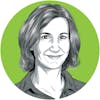 See
more of the story
See
more of the story
Cathy Bratter misses faces.
She paints them over and over; smiling and serene, leaning close together on the canvas. No masks, no social distance. Just faces with mouths quirking up at the corners as if they're about to tell her something.
"A picture paints a thousand words," she said. "That has never been more true to me."
Bratter, a Minnetonka artist, communicates by lip reading. Or she did, before all the lips vanished behind masks.
COVID-19 has killed more than 80,000 Americans, and masks are one of the few things that can help slow the spread. But for thousands of Minnesotans with hearing loss, the masks are a barrier to communication that leaves them isolated and misunderstood.
Bratter, who lost hearing completely as an adult, has always navigated the hearing world with confidence and humor. Nothing prepared her for life as a lip reader with no reading material.
"I built a way of life for myself where I did not feel handicapped," she said. "Until now."
Until the virus came, and she found herself facing masked doctors, masked pharmacists, masked grocery store workers, masked post office clerks and masked passersby.
She can't see what they're saying, and with fabric concealing everything from the eyes down, she can't tell how they're feeling.
"There are no emotions to read," she said. It's hard to tell if the clerk at the post office is smiling, or whether they're "happy or sad or mad, which are important to see for understanding when you lip read," she added. "Imagine Mona Lisa wearing a mask!"
She worked with a seamstress and a few precious sheets of hard-to-find polymer to reopen a window on her world.
Together, they produced a few clear face masks — cloth masks with a square of anti-fog plastic over the mouth that lets her lets her see what the person behind the mask is trying to say.
The mask helped her communicate with her companion on her last trip to Costco, but very few public spaces seem to have clear masks or face shields.
"It's just awful, trying to pick up a prescription," she said. "I have to say 'I don't hear. And I know you want to know my name and my birth date. I'll write down anything else you need.' "
She's debated different fixes. Maybe a dry-erase board? She doubts whether anyone would want to touch the board or share the marker. Texting would mean sharing her number with strangers. Maybe a translation app could transcribe what people are saying?
People with hearing loss aren't the only ones who feel isolated behind a mask. Mask fabric muffles voices, absorbs sound and makes conversation a chore.
So much of what we hear depends on what we see. When doctors wear face masks during consultations, studies found that patients viewed them as less empathetic and caring.
Wearing a mask is one of the most caring, compassionate things we can do for each other right now. Every person behind a mask is a person who cares whether you live or die.
Their mask protects you. Your mask protects them.
But the same masks that can slow the spread of germs can cover our smiles and hide our words. We should care about that too.
"I have no idea when someone is talking to me without seeing a mouth move," Bratter said. "So people may think I am rude or a snob by not replying."
If you're crafty, and if you have access to anti-fog plastic, like clear vinyl stadium bags, you can find clear face mask patterns online.
"Clear face shields need to be in more places, especially where communicating and safety is an issue like in hospitals, airplanes," Bratter said. Stores and public spaces "need more pens and paper as an option or dry marker and board to write on to communicate with the hard of hearing.
If you do make or find a clear mask, you might not meet one of the more than 30 million Americans with hearing loss. But you'd be able to turn to the next person you meet and give them a smile.
jennifer.brooks@startribune.com • 612-673-4008
Follow Jennifer on Twitter: @stribrooks






